
|
Ductile cast iron pipes with integral joints are the conventionally used cast iron pipes that are employed for buried installation. The only exception is made for jacking pipes that do not possess a “smooth outer contour” according to the definition for jacking pipes (see (Pipe materials and joints)). Pipes of this type of construction are only suitable for pulling-in in connection with HDD or for the subsequent pulling-in into casing and host pipes … |
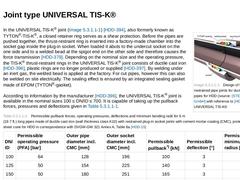
|
(Image: Design of flexible, tensile restrained pipe joints for ductile cast iron pipes for HDD – UNIVERSAL TIS-K®)In the UNIVERSAL TIS-K® joint (Figure 235 a) [HDD-394], also formerly known as TYTON®-TIS-K®, a closed retainer ring serves as a shear protection. Before the pipes are pushed together, the thrust-restraint ring is inserted into a factory-made chamber into the socket gap inside the plug-in socket. When loaded it abuts to the undercut socket … |
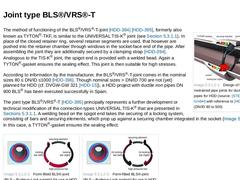
|
(Image: Design of flexible, tensile restrained pipe joints for ductile cast iron pipes for HDD – BLS® (DN/ID 80 to 500))The method of functioning of the BLS®/VRS®-T-joint [HDD-394] [HDD-395], formerly also known as TYTON®-TKF, is similar to the UNIVERSAL TIS-K® joint (see (Joint type UNIVERSAL TIS-K®)). In place of the closed retainer ring, several retainer segments are used, that however are pushed into the retainer chamber through windows in the … |

|
Ductile cast iron pipes with integral joints are the conventionally used cast iron pipes that are employed for buried installation. The only exception is made for jacking pipes that do not possess a “smooth outer contour” according to the definition for jacking pipes (see (Pipe materials and joints)). Pipes of this type of construction are only suitable for pulling-in in connection with HDD or for the subsequent pulling-in into casing and host pipes … |

|
On ductile cast iron pipes for water supply pipelines with allowable maximum operating pressures (PFA) according to DIN EN 545 [HDD-382], welding by electric arc welding can be carried out by means of special nickel- iron electrodes [HDD-395]: -
welding of sockets made of ductile cast iron or steel DN 2",
-
welding of outlets made of ductile cast iron or steel DN 80 to DN 300,
-
wall flanges for integration into constructions,
-
manufacturing flanged …
|

|
At the factory, ductile cast iron pipes for use in buried applications are protected against external attack by aggressive soils [HDD-404] and or filling materials with suitable protective coatings according to DIN EN 545 [HDD-382]. The following variants are to be considered as external protection [HDD-396]: -
zinc coating with bitumen cover coating according to DIN 30674-3 [HDD-405],
-
zinc-aluminium coating with cover coating made of epoxy or polyurethane (…
|

|
Ductile cast iron pipes must be installed in such way that the external protection is not damaged. Due to the socket design, the pipe joint represents a particularly sensitive area in this connection. DVGW GW 321 [HDD-15] stipulates that, for the joint areas, heat-shrinking sleeves (shrinking material) according to DIN 30672 [HDD-333] (see (Pipe joints)) or rubber sleeves should be used as suitable external joint protection. In all cases, these external … |

|
|

|
Against internal corrosion as a consequence of aggressive water and biogenic sulphuric acid corrosion (BSC, see [HDD-43]), ductile cast iron pipes and fittings are standard protected with factory-made cement mortar linings. Furthermore, cement mortar lining serves the purpose of preventing an impact on the quality of drinking water by corrosion products [HDD-410]. For the inner surface of water pipelines, for example, the cement mortar lining according … |

|
Ductile cast iron is a ductile iron-carbon material whose carbon content predominantly consists of graphite in free form. Ductile cast iron mainly differs from the grey cast iron, which is nowadays no longer used for buried supply and discharge lines, in the shape of graphite particles [HDD-379]. Grey cast iron contains lamellar graphite, whereas ductile cast iron contains graphite spheres or spheroidal graphite. The shape of graphite mainly influences … |
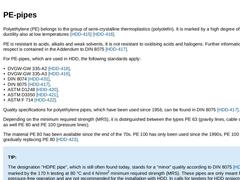
|
Polyethylene (PE) belongs to the group of semi-crystalline thermoplastics (polyolefin). It is marked by a high degree of flexibility and ductility also at low temperatures [HDD-415] [HDD-416]. PE is resistant to acids, alkalis and weak solvents. It is not resistant to oxidising acids and halogens. Further information in this respect is contained in the Addendum to DIN 8075 [HDD-417]. For PE-pipes, which are used in HDD, the following standards apply: |
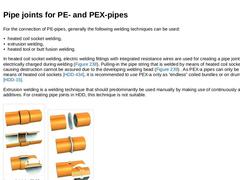
|
For the connection of PE-pipes, generally the following welding techniques can be used: -
heated coil socket welding,
-
extrusion welding,
-
heated tool or butt fusion welding.
In heated coil socket welding, electric welding fittings with integrated resistance wires are used for creating a pipe joint. They are electrically charged during welding (Figure 238). Pulling-in the pipe string that is welded by means of heated coil sockets without causing destruction … |
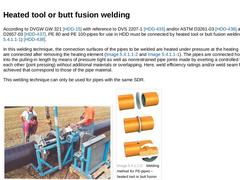
|
According to DVGW GW 321 [HDD-15] with reference to DVS 2207-1 [HDD-435] and/or ASTM D3261-03 [HDD-436] and ASTM D2657-03 [HDD-437], PE 80 and PE 100-pipes for use in HDD must be connected by heated tool or butt fusion welding (Figure 240) [HDD-438]. In this welding technique, the connection surfaces of the pipes to be welded are heated under pressure at the heating element and are connected after removing the heating element (Figure 239 and Figure … |
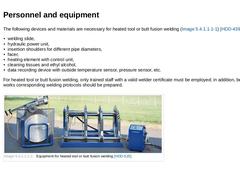
|
The following devices and materials are necessary for heated tool or butt fusion welding (Figure 241) [HDD-439] [HDD-440]: -
welding slide,
-
hydraulic power unit,
-
insertion shoulders for different pipe diameters,
-
facer,
-
heating element with control unit,
-
cleaning tissues and ethyl alcohol,
-
data recording device with outside temperature sensor, pressure sensor, etc.
For heated tool or butt fusion welding, only trained staff with a valid welder … |
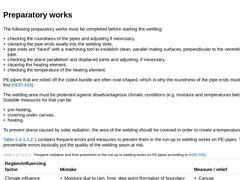
|
The following preparatory works must be completed before starting the welding: -
checking the roundness of the pipes and adjusting if necessary,
-
clamping the pipe ends axially into the welding slide,
-
pipe ends are “faced” with a machining tool to establish clean, parallel mating surfaces, perpendicular to the centreline of each pipe,
-
checking the plane parallelism and displaced joints and adjusting, if necessary,
-
cleaning the heating element,
-
…
|

|
The following working steps are necessary: -
adjusting (Figure 242a),
-
heating (Figure 242b),
-
relocating (Figure 242c),
-
joining (Figure 242d).
The pressures and times that must be observed for the welding process must be taken from the information by the manufacturer (see e.g. Table 79). (Table: Table 79: Guideline values for heated tool or butt fusion welding of PE-pipes and fittings at an atmospheric temperature of around 20 °C (68°F) and moderate … |

|
(Image: Working steps for PE-welding with corresponding temperature diagram – Joining)Welding works must be monitored. The type and extent must be arranged between the contract partners. It is recommended to document the process data in welding protocols or on data storage media [HDD-435] [HDD-441]. The welding protocol must contain the following data (cf. also diagram in Figure 242 d): -
melting temperature,
-
melting time,
-
jointing pressure.
|
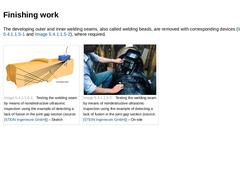
|
The developing outer and inner welding seams, also called welding beads, are removed with corresponding devices (Figure 243a and b), where required. (Image: Testing the welding seam by means of nondestructive ultrasonic inspection using the example of detecting a lack of fusion in the joint gap section – Sketch) (Image: Testing the welding seam by means of nondestructive ultrasonic inspection using the example of detecting a lack of fusion in the … |

|
According to DVGW GW 321 [HDD-15] with reference to DVS 2207-1 [HDD-435] and/or ASTM D3261-03 [HDD-436] and ASTM D2657-03 [HDD-437], PE 80 and PE 100-pipes for use in HDD must be connected by heated tool or butt fusion welding (Figure 240) [HDD-438]. In this welding technique, the connection surfaces of the pipes to be welded are heated under pressure at the heating element and are connected after removing the heating element (Figure 239 and Figure … |

|
The destruction-free check of the welding seam can be carried out in three ways according to EN 13100 [HDD-442]: -
visual inspection,
-
X-ray testing,
-
ultra-sonic testing.
Visual inspection checks butt welds according to the following criteria (Figure 243 a): -
The welding beads have to be equally round and clearly visible.
-
All beads are supposed to be of equal size approximately.
-
The bead surfaces have to be smooth.
-
The beads are supposed to be free …
|

|
For the connection of PE-pipes, generally the following welding techniques can be used: -
heated coil socket welding,
-
extrusion welding,
-
heated tool or butt fusion welding.
In heated coil socket welding, electric welding fittings with integrated resistance wires are used for creating a pipe joint. They are electrically charged during welding (Figure 238). Pulling-in the pipe string that is welded by means of heated coil sockets without causing destruction … |

|
If, due to the soil conditions, impermissible mechanical stress of the pipes or damage to the pipe surface (e.g. scratches, point loads and grooves) is expected (which can always be assumed when directly pullingin the pipe string into the borehole) according to [HDD-15], an additional external pipe protection must be used for PE 80- and PE 100-pipes. In order to ensure its protective effects, the outer protective layer must comprise at least 10% of … |

|
(Image: PE 100-pipe with dimensionally added protective coating of minerally reinforced PP of the type egeplast SLM®2.0 (SLM – Safety-Line® host pipe))In order to produce pipes with dimensionally added protective coating, according to DIN 8074 [HDD-431] and DIN 8075 [HDD-417], standard pipes of PE 80 or PE 100 (so-called core pipes) are, in a second production step, separately coated with another material such as mineral reinforced polypropylene … |

|
In pipes with dimensionally integrated protective layer (also called coextruded pipes), the PE-pipes are inseparably connected with a protective layer, e.g. silane cross-linked polyethylene (PEX-b), to improve the material properties (increased strength values by increases to the yield stress and reduction of the ultimate strain) so that the outer diameter to DIN 8074 [HDD-431] can be adhered to [HDD-445]. It is differentiated between coextruded two-… |

|
If, due to the soil conditions, impermissible mechanical stress of the pipes or damage to the pipe surface (e.g. scratches, point loads and grooves) is expected (which can always be assumed when directly pullingin the pipe string into the borehole) according to [HDD-15], an additional external pipe protection must be used for PE 80- and PE 100-pipes. In order to ensure its protective effects, the outer protective layer must comprise at least 10% of … |